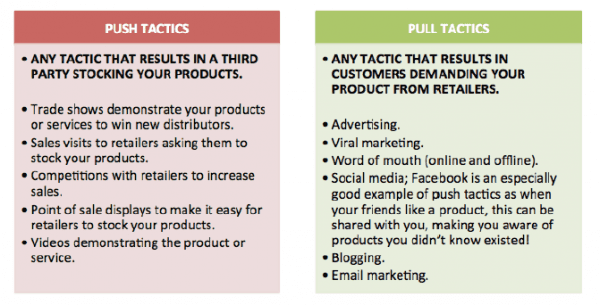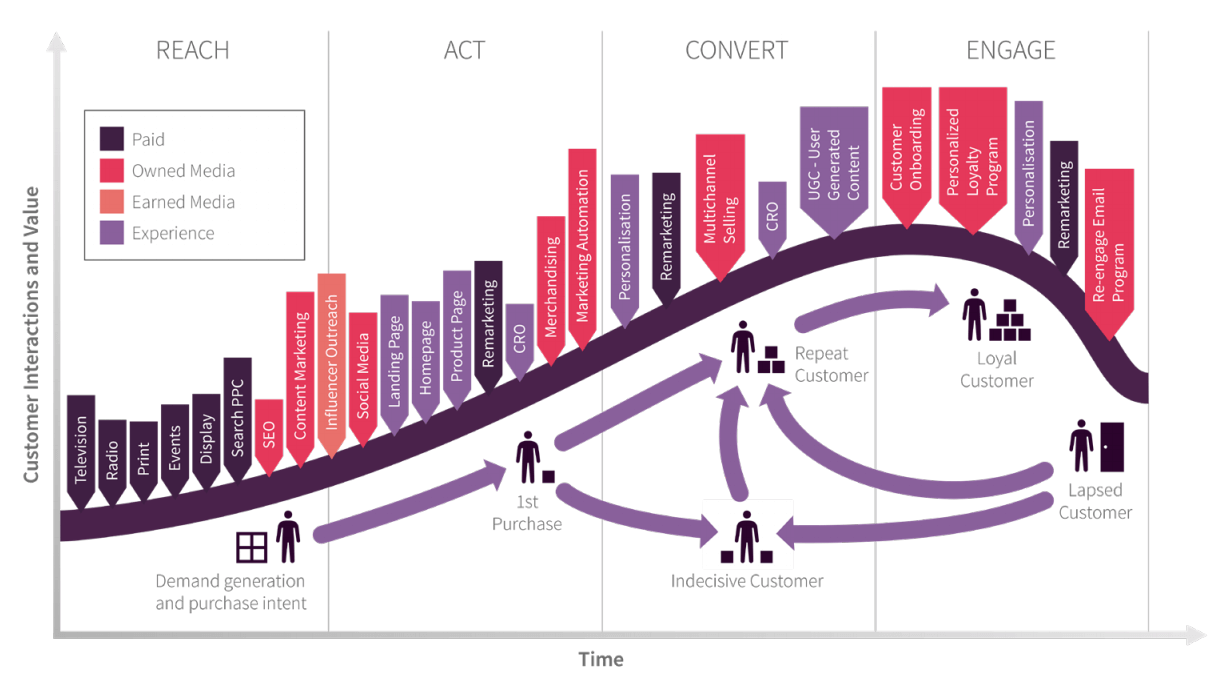The push and pull model is popular for optimizing sales tactics. E-commerce, manufacturing, and branded goods marketers in particular must employ a mix of both push comms an inbound pull factors
What is push and pull distribution strategy?
Push and pull distribution strategy is all about directing your promotional route to market. Either by the product being pushed towards customers or your customers pulling the product through the retail chain towards them.
This method is crucial for supply management for manufacturers, brands, and online retailers planning promotional strategies. Here are the tactics associated with push and pull distribution strategy:

How to use the push and pull distribution model
There are many advantages and disadvantages of both models, as it depends on your business. For instance, manufacturers tend to use a push strategy for finding distributors to promote their products.
For example, Mars who manufacture chocolate bars, sell via distributors. It would impossible to manage requests to buy single bars of chocolate! They have a large product portfolio and sell ranges into their distributors.
For consumer branded goods, they often use pull strategies, for example, Intel, the computer chip company created 'Intel Inside' their brand ingredient programme by persuading manufacturers that their computers would have higher perceived value if they featured Intel in their own marketing, resulting in customers wanting to know if the PC they were buying included an Intel chip.
A good tip is to look at your competitors: What are they doing? Push or pull? Look at overseas competitors too as they may have introduced other ideas.
Looking to optimize your customers' journeys?
If you've already planned your push and pull distribution strategy, next you need to think about how to put these messages infront of your customers and create that elusive inbound demand. We recommend breaking down your customer touchpoints across the RACE Framework of Reach, Act, Convert and Engage, so you can use data and best-practice to measure and tweak your push and pull key messages.
Our popular RACE Framework gudies marketers, managers, and their teams through each stage of the customer lifecycle, creating a streamlined and efficient marketing strategy to acquire and retain even more customers. The RACE Framework can be applied to B2B, B2C and D2C sales cycles. It can be broken down into a granular audit of each marketing activity, or used as a 1 page summary. This template is being used by marketers in both large and small businesses to drive the results they need. Get started today.

Core Module

Structure a plan using Smart Insights’ RACE
Part of the Digital marketing strategy and planning Toolkit
Learn how to structure a comprehensive omnichannel marketing plan, using Smart Insights' RACE
Learn MorePros and cons of push and pull distribution strategy
As would be expected, there are advantages and disadvantages to both push and pull strategies:
Push Strategy
Advantages of the Push Strategy
- Useful for manufacturers seeking distributor for product promotion.
- Useful for those manufacturing or those selling low value items as a distribution who is likely to place bulk items.
- Creates product exposure in potentially large retail environments.
- Good way to test new products in the market.
Disadvantages of the Push Strategy
- The distributor may source alternative products (cheaper, faster delivery) once your product has established the market need.
- Distributors may not organise a formal contract, so no guarantee of regular orders.
- Distributors may demand financial contribution towards promotion.
- Distributors may demand lower prices to fit in with their promotional campaign.
- Distributors can establish dependence and then request price reductions
- Distributors can demand lengthy credit terms.
Pull Strategy
Advantages of the Pull Strategy
- Direct contact with customers.
- Instant payment as customers do not have credit facilities and pay online or in store at the checkout.
- Greater margins as no discount needed.
- Customers can generate ideas for new product development.
- Ideal for premium priced products.
Disadvantages of the Pull Strategy
- Greater administration required in-house to fulfil customers’ orders.
- Many smaller and one-off orders.
An example of the Push and Pull model
How does your business operate right now? If you only sell via retailers, you have a push strategy. If you sell to merchants like supermarkets or major retailers, the challenge is often when your product establishes sufficient demand; the merchant may wish to replace your product with its own alternative. If you only sell direct to customers, that’s a pull strategy.
As markets, the environment and customers change, it’s wise to consider both strategies. Household brand, Thornton’s Chocolates, operate both strategies in different ways.They have an own label option and sell to specific retailers and package their goods using the retailers’ own brand packaging and they sell direct to customers via high street stores, online and in other retailers.
Push and pull distribution strategy - what to watch for
To grow a business you may need both strategies. A push strategy gets a larger volume of products out to customers faster. A pull strategy can take longer and involve many smaller orders. We've got marketing tools and templates to help you build a focused, omnichannel strategy to drive the results your business needs to achieve success. Find out more.
Core Module

Digital strategy success factors
Part of the Digital marketing strategy and planning Toolkit
Learn how to define a structure and scope for your omnichannel marketing strategy
Learn MoreOriginal Source
We haven’t been able to track down the original source! We’ve looked through The Chartered Institute of Marketing’s EBSCO database containing access to thousands of journals, articles and other publications dated back to 1902 and it’s not there. We can assume it was created before this time.
Anonymous (n.d.).









